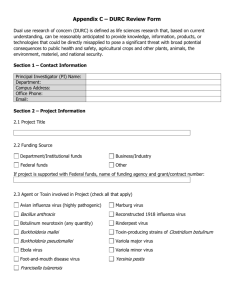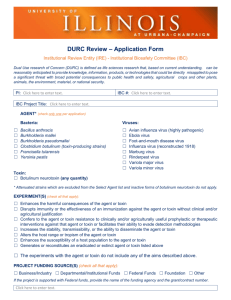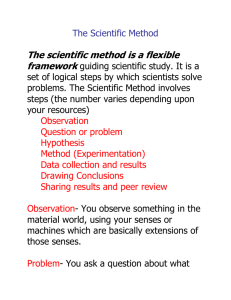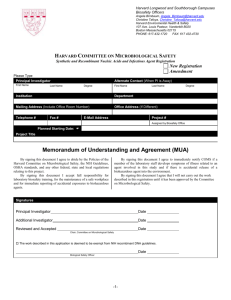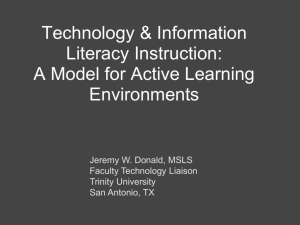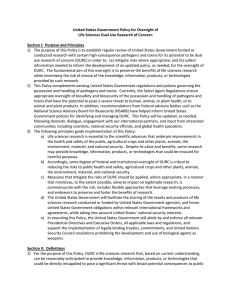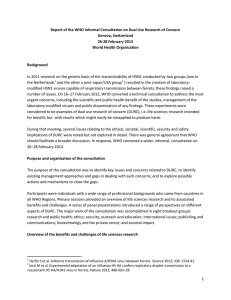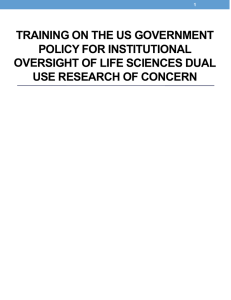problem - experimentation - discovery The scientific process
advertisement
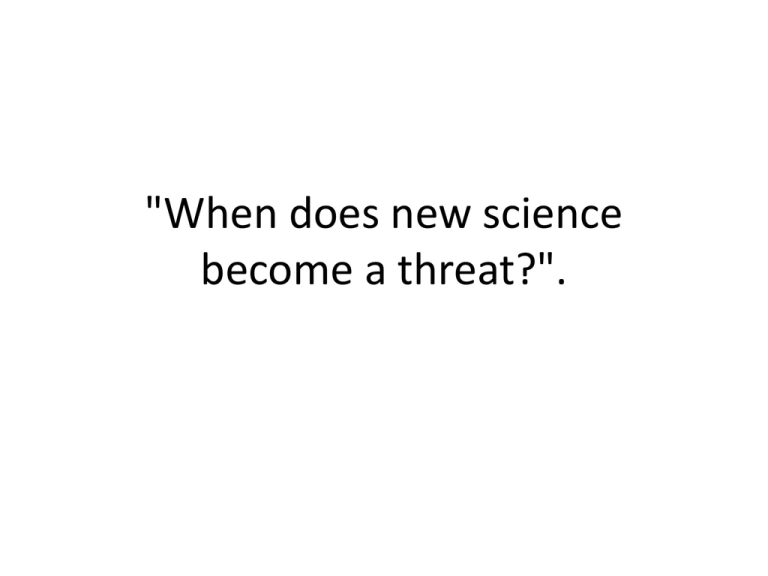
"When does new science become a threat?". The scientific process problem - experimentation - discovery The scientific process problem - experimentation - discovery - dissemination The scientific process problem - experimentation - discovery - dissemination Where do …………….. intervene in the process to identify DURC Controversial biological publications • Jackson et al. 2001: Expression of Mouse Interleukin-4 by a Recombinant Ectromelia Virus suppresses cytolytic Lymphocyte Responses and Overcomes Genetic Resistance to Mousepox • Cello et al. 2002: Chemical synthesis of Poliovirus cDNA: Generation of infectious Virus in the Absence of a natural Template • Tumpey et al. 2005: Characterization of the reconstructed 1918 Spanish Flu influenza Pandemic Virus • Wein et al. 2005: Analyzing a Bioterror Attack on the Food Supply: The Case of Botulinim Toxin in Milk • Herfst et al. 2012: Airborne Transmission of Influenza A/H5N1 Virus between Ferrets • Imai et al, 2012: Experimental Adaptation of an Influenza H5 HA confers respiratory Droplet Transmission to a Reassortant H5 HA/H1N1 Virus in Ferrets • Xiong et al. 2013: Receptor binding by a ferret-transmissible H5 avian Influenza Virus • Bieringer et al. 2013: Experimental Adaptation of Wild-Type Canine Distemper Virus (CDV) to the Human Entry Receptor CD150 • Zhang et al 2013: H5N1 Hybrid Viruses Bearing 2009/H1N1 Virus Genes transmit in Guinea Pigs by Respiratory Droplet The scientific process problem - experimentation - discovery - dissemination Vanity publishing Where do …………….. intervene in the process to identify DURC The scientific process problem - experimentation - discovery - dissemination Where do …………….. intervene in the process to identify DURC The scientific process Funding Scientists Open innovation problem - experimentation - discovery - dissemination - repetition - adoption Science is a moving target – good science identifies new ground The pace of change Introduce new traits into an organism at the genetic level 1 Use an existing pathway to make something new. 2 Engineer an organism to modify to an existing pathway 3 Engineer an organism to do something completely new 4 Engineer a new functional organism from scratch 5 The politics of 20/20 hindsight The pace of change Can we prevent access to new sciences: e.g. oligonucleotide synthesis Interferon gamma 17kDa, 166aa, 498 bp Code of conduct – what is you want scientists to do differently? Security culture – responsible conduct The scientific process problem - experimentation - discovery - dissemination Where do …………….. intervene in the process to identify DURC Self policing Constant vigilance!! • • • • • Provide education – at all levels Engender a community responsibility Provide a reporting framework Provide confidential contacts Provide a knowledge base A problem Categories of Experiments that might be DURC 1. Enhance the harmful consequences of a biological agent or toxin. 2. Disrupt immunity or the effectiveness of immunization without clinical and/or agricultural justification. 3. Confer to a biological agent or toxin, resistance to clinically and/or agriculturally useful prophylactic or therapeutic interventions against that agent or toxin or facilitate their ability to evade detection methodologies. 4. Increase the stability, transmissibility, or the ability to disseminate a biological agent or toxin. 5. Alter the host range or tropism of biological agent or toxin. 6. Enhance the susceptibility of a host population. 7. Generate a novel pathogenic agent or toxin, or reconstitute an eradicated or extinct biological agent. National Science Advisory Board for Biosecurity (NSABB), USA, 2012; http://oba.od.nih.gov/biosecurity/biosecurity_documents.html Emerging Science Makes Security a Moving Threat Beyond the 15 Key Pathogens/7 Core Experiments of Concern – moving target A problem No common framework in which to conduct sound risk/benefits analyses of science: • In different countries • In different cultures • In different communities (e.g. science vs. security) Therefore probability that too risky experiments yielding too little benefit will be conducted. • However, can we apply universal rules? • Should the restrictions/expectations placed on a 3rd world be the same as a developed nation? • Rather do we really need common ethical guidance? Who provides the solution Quid est veritas: What is truth • Convergence of science • Divergence of scientists - in interest/expertise - who is doing the science - including “the public” Safety Risk Security Threat The language Advise on risk/benefit assessment and risk mitigation • don´t do it • do it in another way Dissemination • don’t publish it • publish it with balancing/redacted information • Advise on supporting structures, e.g. local/regional ethical review committees What is the cost of security? “The biological world is displacing the machine as a general world of design.” DARPA – Living Foundries: Large U.S. investment in nextgeneration bio-based manufacturing Unknown unknowns – horizon scoping and the pace of scientific development • Most science develops iteratively and easy to map. • Some scientists work in a different way and think about where they want to be and describe the route to get there, real scientific breakthrough • Step change is often serendipitous, or is unrecognized at the point of discovery. • Nature as a threat – biggest bioterroist. How good at this are we? Scientists are good at identifying where science is going in the near future Horizon scoping 10 years and beyond less reliable – pace of change Dealing with potential issues in advance …. Discussion between science, policy and security …. Identifying a clear and present danger Coreponsibility …..
